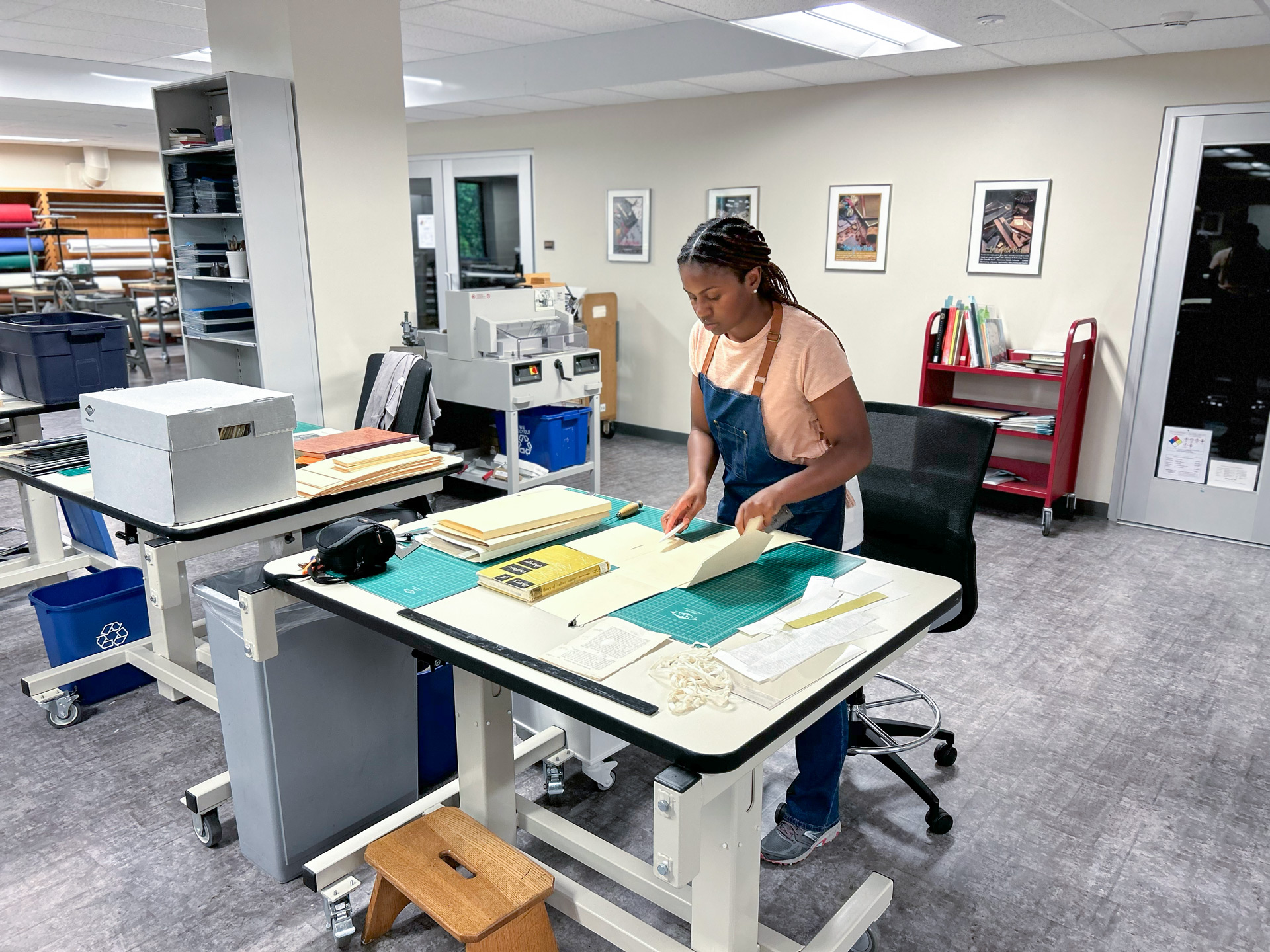HBCU Library Alliance Internship offers area student opportunity to experience KU Libraries
After Aryana Derritt left her home in Wyandotte County to start a biology degree at Fisk University in Nashville, Tennessee, the lower levels of KU’s Spencer Research Library were nearly 600 miles – and several magnitudes of relevancy – off her intended path. Yet, a digitization project completed as a part-time student worker in Fisk’s library piqued her interest in library conservation and led her to Lawrence this summer where she recently completed a Historically Black Colleges and Universities (HBCU) Library Alliance Preservation Internship with KU Libraries.

Derritt, a rising sophomore and graduate of nearby Piper High School, was barely familiar with the range of occupations at academic libraries before spending the last month on KU’s campus getting to know librarians from across multiple units and working directly in conservation services. Derritt found further personal purpose in the preservation work when she stumbled upon a Sumner High School yearbook during a tour with the Kansas Collection Curators and found a photo of her grandmother and other relatives.
Derritt, who also studies business administration, isn’t planning a career change yet, but the experience has achieved the HBCU Library Alliance’s goal of providing undergraduate students interested in humanities, arts, and sciences an opportunity to learn and practice library preservation skills during a six-week internship under the mentorship of professional conservators and library staff at host sites. In addition to KU, this year’s participating research universities include Brown, Duke, Harvard, Texas, Yale, and the Library of Congress.
KU Libraries has been a part of the program for four years, but Derritt is the first intern to spend time on campus due to the COVID-19 pandemic. Nearly 40 students have completed the program, and some have pursued careers related to librarianship. Funding for these internships comes from the Samuel H. Kress Foundation, the University of Delaware College of Arts and Sciences, the Department of Art Conservation at the University of Delaware, Winterthur Museum, Garden and Library (DE), and host institutions like KU Libraries. Derritt’s supervisor at Fisk told her about the internship with the alliance, a collection of librarians across the country that aims to empower Historically Black Colleges and Universities by supporting the collaboration of informational professionals.
“I really wanted to learn what a librarian does because I didn’t know there were many different careers and aspects to the profession,” Derritt said. “It’s always nice to be well-rounded and learn more things.”
The internship was six weeks long, with two weeks online and four weeks onsite. Students participate in an online class for two days every week – taught by the various site hosts – and make a final presentation at the end of the summer. While on campus, Derritt was trained to do hands-on preservation work with help from conservation services staff.
Conservation Services at Spencer Research Library are responsible for the care and repair of paper-based materials and the libraries’ audio/visual collections. By preserving those collections, the department ensures that they continue to be accessible to those who need to use them.
Whitney Baker, KU Libraries’ head of Conservation Services, and her unit have worked to create a well-rounded, yet personalized experience for interns, while offering opportunities for networking throughout the libraries.
“We’ve worked with the interns to craft a specialized program for them based on their interests, but those internships have always included meeting everyone from the librarians and curators, to public services, to audio/visual preservation – which is part of our department – processing, and public areas,” Baker said. “All sorts of components of this field, just to whet people’s appetite.”
A further benefit and goal for the program is the potential to increase representation among preservation staff, particularly for individuals who have not had the chance to experience working in conservation.
“Our field is not particularly diverse and we really want everyone at the table who wants to be there,” Baker said. “Introducing students who might not have had a chance to work with a preservation department, this is a great way to get more people in the door and diversify our field.”
Derritt, who enjoyed exploring topics outside of her usual studies, listed the work, the people, the workplace environment, and the stories of those historic items that she has helped preserve this summer as highlights of the opportunity.
“The work that goes into being a librarian, and really the stories and the joy that they really find working in the library,” Derritt said. “I’ve seen the work environment here – they have a really great work environment. The opportunities – you’re not always just doing one thing every day. The opportunity to work with others – collaboration. They have really cool projects, especially in special collections. They get to work on really different things and they get to learn about the history of items – that’s what’s really satisfying because you get to tell a person’s story and share it with the world.”